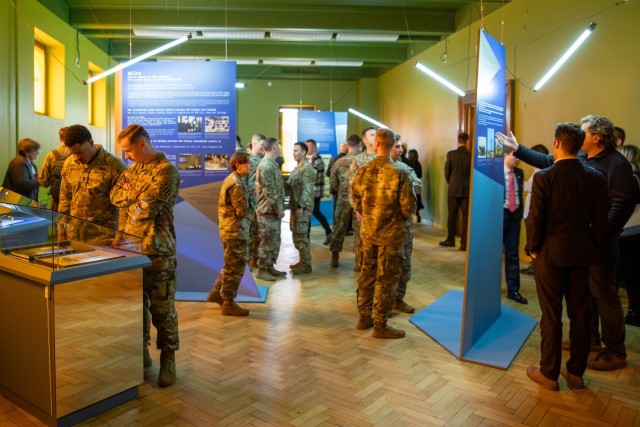RIGA, Latvia — U.S. and Latvian service members, diplomats and other guests gathered last week at the Latvian War Museum’s opening of a new exhibit commemorating the 32-year history of the U.S.-Latvia military partnership.
“Message Follows,” which opened April 11, highlights the beginning and renewal of U.S.-Latvian cooperation, U.S. support for developing the Latvian National Armed Forces, and the long-standing partnership between the Michigan National Guard and the Latvian National Guard. The exhibit features video interviews, uniforms, equipment, and personal belongings of U.S. Army active component and Michigan National Guard Soldiers who have served with Latvian soldiers during the Afghanistan War. This exhibit tells the story of their shared history while also highlighting the enduring strength of the U.S.-Latvia security partnership.
“The exhibition ‘Message Follows’ marks our 30-year plus partnership with the Latvian National Armed Forces. It is really a testament to the close partnership that we’ve had and that we continue to enjoy here with our Latvian allies. It showcases their contributions to U.S. operations in the past, and then vice versa,” said Lt. Col. Ross Kastner, chief of the U.S. Office of Defense Cooperation in Latvia.
The U.S.-Latvia military partnership began in 1993 when Latvian defense forces signed a formal partnership with the Michigan National Guard through the Department of Defense National Guard State Partnership Program (SPP). The SPP links National Guard units in states with the national military organization of a partner or ally nation in a cooperative, mutually beneficial relationship. The Michigan-Latvia cooperation was one of the pioneers of the SPP, which has now expanded to 105 partnerships with 115 nations. The SPP has helped in the development of the Latvian National Guard, medical and engineer cooperation, the establishment of Latvia’s Joint Terminal Attack Controller program, multiple combined deployments to Afghanistan, and the certification of Lielvārde Airfield as a fully functioning base for NATO air power.
“This exhibition not only invites us to reflect on what has been accomplished but also encourages us to look forward to the future,” said Kristine Skrivere, director of the Latvian War Museum. “Its title, ‘Message Follows,’ is a phrase used in modern communication to indicate that information is still in progress, and that we must remain connected, exchanging clear and understandable messages. The title also carries a symbolic meaning, a reminder that our shared story continues.”
Since 2016, the United States and Latvia have participated in the U.S.-Baltic Dialogue to broaden and deepen the U.S. range of security cooperation activities and address Baltic-wide security gaps. The U.S. has assisted in enhancing Latvia’s territorial defense capabilities, including electronic and hybrid warfare, border security, and maritime and air domain awareness. This cooperation promotes interoperability with the United States and NATO and helps Latvia support its security commitments abroad.
“The United States is firmly committed to NATO and to European security—keeping Americans safe means keeping NATO strong. That commitment is not abstract—it is real and it is visible right here in Latvia, where our forces train together, operate together, and stand ready together to deter and defend,” said Christopher Robinson, the U.S. Ambassador to the Republic of Latvia.
U.S. and European cooperation remains focused on addressing global challenges, supporting economic development and reinforcing diplomatic ties. The transatlantic relationship is a resilient and adaptable partnership that is central to promoting international stability and collective security.
“This exhibition reminds us that passionate partnership also has its own language. The cooperation between Latvian and U.S. armed forces is a living example of that, built on shared values, common missions and constant readiness,” said Maj. Gen. Kaspars Pudans of Latvian National Armed Forces. “Our cooperation is needed [and] is framed by decades of trust, joint exercises, training of our soldiers, our operational deployments and also personal bonds, making this partnership not only effective, but also very deeply meaningful.”




Social Sharing